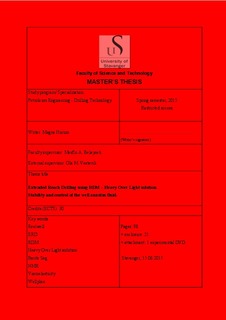| dc.contributor.author | Hurum, Magne | |
| dc.date.accessioned | 2015-09-21T13:11:39Z | |
| dc.date.available | 2015-09-21T13:11:39Z | |
| dc.date.issued | 2015-06-15 | |
| dc.identifier.uri | http://hdl.handle.net/11250/300944 | |
| dc.description | Master's thesis in Petroleum engineering | nb_NO |
| dc.description.abstract | The oil and gas industry has large benefit from cost reductions and increased efficiency. One of the segments that is most affected by these factors is the drilling industry. There are large costs related to rig rates, equipment and manpower. One solution to these challenges is extended reach drilling (ERD). By using fewer rigs where each is capable of reaching further, there is a large potential for cost reductions. One of the companies that delivers ERD technology is Reelwell, located in Stavanger, Norway. The company has developed their own extended reach drilling technology named the Reelwell Drilling Method (RDM).
One of the features of the Reelwell Drilling Method (RDM) is the Heavy Over Light (HOL) solution. The concept is comprised of using two drilling fluids with different densities on the inside and the outside of the drill string. This creates an increased buoyancy force on the drill string, making it possible to drill further due to the reduced torque and drag effects. The fluid on the outside of the drill string must be able to keep the weight material in suspension to avoid operational problems and loss of well control.
The thesis presents an experimental study of weight particle sagging in horizontal sections. The focus has been on both dynamic and static sag in oil-based mud (OBM), with both standardized and non-standardized experiments such as NMR, viscoelasticity and rig testing. A modern (BaraECD) and a standard (OBDF01) oil-based drilling fluid were tested. The BaraECD showed preferred properties having high ES values and low density variations in dynamic sag scenarios. The measurements showed that there is a potential of static and dynamic sag in a horizontal well section. Wellplan simulations and buoyancy calculations showed that sag is not expected to be a problem for the pipe buoyancy when using the HOL solution. The results indicate that sag rather can be beneficial by increasing drill string buoyancy and thereby reduce torque and drag effects. | nb_NO |
| dc.language.iso | eng | nb_NO |
| dc.publisher | University of Stavanger, Norway | nb_NO |
| dc.relation.ispartofseries | Masteroppgave/UIS-TN-IPT/2015; | |
| dc.subject | petroleum engineering | nb_NO |
| dc.subject | petroleumsteknologi | nb_NO |
| dc.subject | boreteknologi | nb_NO |
| dc.title | Extended reach drilling using RDM - heavy over light solution. Stability and control of the well annulus fluid | nb_NO |
| dc.type | Master thesis | nb_NO |
| dc.subject.nsi | VDP::Technology: 500::Rock and petroleum disciplines: 510::Petroleum engineering: 512 | nb_NO |
